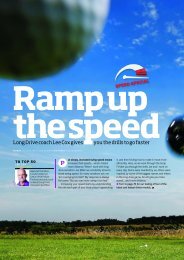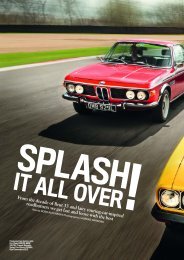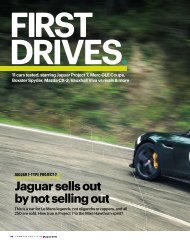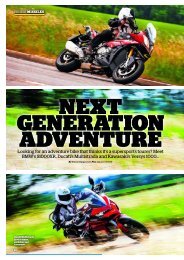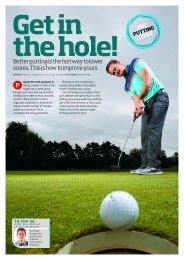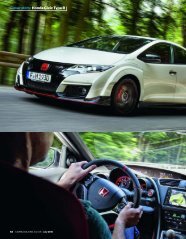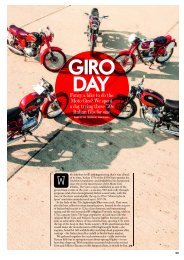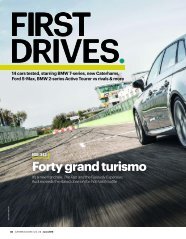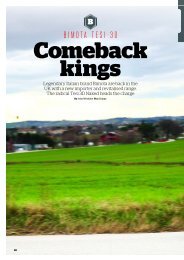Motorbikes.pdf
Create successful ePaper yourself
Turn your PDF publications into a flip-book with our unique Google optimized e-Paper software.
SUZUKI GSX-R1000 ABS<br />
STILL<br />
GOT<br />
IT<br />
Way back in 1985 the<br />
first Suzuki GSX-R<br />
created indelible<br />
memories. Thirty<br />
summers later and<br />
it’s still hard at it<br />
By Mike Armitage<br />
Pics Chippy in the Wood<br />
36
37
SUZUKI GSX-R1000 ABS<br />
THERE IS NOWHERE FINER on an evening like this. With<br />
the sun tinting the horizon as it slides down a spotless sky<br />
and the air developing a fabulous crispness, it’s as though<br />
the countryside has flicked into HD. Shadows grow depth<br />
and hard edges. Verdant verges buzz with visor-smothering<br />
life and the overhanging canopy sparkles. Work traffic has<br />
long since buggered off and the warm tarmac is invitingly open.<br />
Even that whiff from Daisy and her mates seems to add to the<br />
whole. Britain’s glorious when summer’s in bloom.<br />
And as this is Britain there can really only be one sportsbike that<br />
fits this scene. A sparkling blue Suzuki GSX-R.<br />
Has to be. If your biking history contains sports machinery (and<br />
chances are it does) your internal hard drive will be littered with<br />
Suzuki-flavoured files; the everlasting blue and white, loud cans<br />
and ill-fitting paddock jackets, the family-planning sticker kits and<br />
some preposterously small numberplates. And there’s that GSX-R<br />
reputation – from the standard-setting original and overwhelming<br />
1100s, to the bulletproof oil-cooled motors and FireBlade-beating<br />
humpy SRAD, the Suzuki has never been shy about its intentions.<br />
Ah, yes, all right – I know what you’re thinking. Suzuki’s race<br />
replica isn’t exactly on the leading edge anymore. This GSX-R1000<br />
has new ABS brakes this year, but in a class brimming with traction<br />
control, engine braking control, anti-wheelie and even electronic<br />
suspension this not-very-exciting addition is like hoping a couple<br />
of brisk walks is adequate preparation for running a marathon. As<br />
far as gadgets go the thousand is very much out of shape.<br />
Frankly, I really couldn’t care less.<br />
Flashing through dappled light and bursting into invigorating<br />
evening air, the GSX-R has all the ingredients to feel absolutely<br />
staggering. First up it’s grinning-idiot fast. There’s a most real<br />
165bhp bulging behind the fairing, the inline-four engine having<br />
the potential to exceed 100mph in first gear and making what<br />
traffic there is look like it’s stuck on pause. Part throttle, shortshift,<br />
and you’re still a blurred blue streak. The airbox resonates<br />
with a hollow roar and a grinding, gravelly edge that’s familiar to<br />
anyone who’s owned any GSX-R from the last 20 years. Fuelling is<br />
super-smooth, precise, and the gearbox taps slickly between ratios.<br />
Favourite turns pop into view. After scorching across open<br />
pasture the A-road now bucks steeply up the valley side, turning<br />
tightly back and forth as it cuts through trees over a bumpy,<br />
broken surface. The GSX-R soaks it all up like 186mph kitchen roll.<br />
Showa big-piston forks are supple and absorbent, yet with the<br />
control to keep the Suzuki poised and accurate. With the shock<br />
exhibiting an equal mix of pliancy and governance it’s fantastic<br />
road-friendly suspension. Handling is light and accurate, yet<br />
comfortingly sure-footed. Those Brembo one-piece calipers give<br />
touch-and-stop braking as well, and ABS is only detected when<br />
I do some deliberate emergency stops, just to see what happens.<br />
However, what really lets the GSX-R get under your bark is the<br />
way it connects. We prattle on about how the newest ride-by-wire<br />
bikes have ‘rider aids’ that you can’t feel working; traction control<br />
you don’t know is intervening, smooth anti-wheelie, that sort of<br />
thing. And it’s all true – ride Yamaha’s R1 or Ducati’s 1299 Panigale<br />
and the electronics just beetle away unseen in the background.<br />
‘The road bucks over a broken,<br />
bumpy surface... the GSX-R soaks<br />
it up like 186mph kitchen roll’<br />
Sportsbikes: way too<br />
powerful, far too fast.<br />
But on an evening like<br />
this there’s nothing<br />
that can get close<br />
38
Top left: refined anti-lock<br />
system is the update for<br />
this year’s GSX-R1000;<br />
Clockwise from top right:<br />
machined and anodised<br />
aluminium Yoshimura<br />
trinkets include engine<br />
sliders, carbon end-can<br />
and natty bar ends, and<br />
enhance the 1000 without<br />
getting too... well, tacky<br />
39
SUZUKI GSX-R1000 ABS<br />
Showa big-piston forks, classy yoke, neat logo<br />
– the days of flimsy Suzuki build are long gone<br />
Not the TV-size digi screen of rivals, but info is<br />
easy to find and analogue tachos are still cool<br />
The big GSX-R has used LED lights for 12 years,<br />
but now they’re more subtle than they were<br />
40
Then you go back to the cable-controlled Suzuki… and rediscover<br />
sensations that made us fall for the sportsbike the first time round.<br />
Admittedly the 1000 has three ‘drive modes’, to restrict grunt if<br />
needed, but if I’ve bought a litre bike I want litre-bike performance.<br />
So stick in full-fat mode A and wind the gas hard. Smoothly and<br />
predictably the front elevates as the needle whips round the tacho.<br />
On the gas mid-corner and feel each degree of twistgrip feeding<br />
another pound-foot of shunt to the rear tyre’s contact patch. Get<br />
giddy and there’s no stuttering exhaust or the sense of someone<br />
pulling back on the seat unit because the ECU thinks you’re being<br />
heavy handed. Instead, there’s just a sense of having total control<br />
over the crank. Plus you know how the forks will feel and react,<br />
whether stuffed into a corner at huge lean or braking over ripples,<br />
because there isn’t a black box tweaking the damping all the time.<br />
Softness isn’t perhaps the right word, but you get the idea. It’s a<br />
connection with analogue warmth, not digital coldness.<br />
Tucked behind a generous screen, rich green smeared either side,<br />
the Suzuki’s pointy end floats off rises and pings up over yumps,<br />
the motor singing with a sharp, rousing pitch as it devours ratios.<br />
These are the feelings of a mighty motor accelerating hard, of a fast<br />
bike going fast – the sensations that have always made exploring a<br />
sportsbike’s abilities so exciting. It’s this liveliness that highlights<br />
the potential, gets blood pumping, makes you whoop in a way a<br />
blinking traction idiot light never can. It’s got to be the closest you<br />
can get to recreating on-board footage from the TT.<br />
I reckon the GSX-R still looks good too, thanks to this MotoGP<br />
version with classy paint, double-bubble screen plus<br />
Yoshimura end-can, bar ends, engine sliders and<br />
anodised whatnots. It draws nothing but positive<br />
reaction wherever I stop, and I think photographer<br />
Chippy’s actually aroused – in summer evening<br />
light it’s breathtaking. It costs £11,034 or £11,434<br />
with ABS; that’s just £300 more than a standard GSX-R<br />
(which also gets a Yoshi can) but two grand less than a<br />
Kawasaki ZX-10R and four thousand cheaper than an R1.<br />
However, it’s the Suzuki’s ability to continue feeling<br />
great when you’re not riding like a silly arse that really<br />
cements its brilliance. The long seat lets you feel like a<br />
WSB hero with cheeks thrust rearward, but cosy-up to the<br />
tank and you’re sports-tourer upright. It’s a deep, wide,<br />
sumptuous-yet-supportive saddle. Footpegs are adjustable.<br />
The mirrors are large and pin, the functions of the dash are<br />
intuitively accessed from the switchgear. There are bungee<br />
points. And ooh, look, look – a pillion seat that a normal human<br />
might realistically consider plonking their arse on for more than<br />
nipping down the road to get milk.<br />
S P E C I F I C A T I O N S<br />
Contact<br />
Price<br />
Engine<br />
Capacity<br />
Fuel system<br />
Transmission<br />
F ra m e<br />
Wheelbase<br />
Rake/trail<br />
Seat height<br />
Tank size<br />
Front suspension<br />
Rear suspension<br />
Brakes<br />
(front/rear)<br />
Wet weight<br />
Economy<br />
G S X - R 1000 ABS MOTOGP<br />
suzuki-gb.co.uk<br />
0845 850 8800<br />
£11,434 otr<br />
liquid-cooled, DOHC<br />
16-valve inline four<br />
999cc<br />
injection<br />
six-speed, chain<br />
aluminium twin spar<br />
1405mm<br />
23.5°/98mm<br />
810mm<br />
17.5 litres<br />
upside down fork, adjustable<br />
preload, rebound, comp<br />
monoshock, adjustable<br />
preload, rebound, 2 x comp<br />
2 x 320mm discs, 4-pot<br />
calipers/245mm, 1-pot<br />
205kg (claimed)<br />
46mpg/177 miles<br />
Bike verdict Today’s sharpest, most hi-tech big<br />
capacity sportsbikes are more like racers on the road<br />
than ever before. The Suzuki isn’t. Instead, it mixes<br />
looks, brain-sizzling pace and more handling that<br />
you need in a flexible, accessible, usable road bike.<br />
And one that, crucially, still feels very much a GSX-R.<br />
Bike rating<br />
+++++<br />
Wednesday<br />
night, 9.30pm,<br />
the middle of<br />
summer, 2015.<br />
Here’s to the<br />
next 30 years<br />
of the GSX-R...<br />
Add in silky throttle, utter controllability and suspension the<br />
opposite of harsh, and it gives the GSX-R usability and friendliness.<br />
You don’t get that with a hard track-focused R1. BMW try to build<br />
it into the S1000RR (their start point was the GSX-R1000 K5, after<br />
all) yet the German is still too rowdy, imposing and expectant –<br />
and, for me, too digital – to reward as an everyday road bike. You<br />
enjoy the Suzuki day in, day out, sun, rain, back lane, motorway.<br />
Hi-viz evening is giving way to dusk, so I park on hills above my<br />
village to watch the glowing embers of a memorable summer day.<br />
Next year sees a new GSX-R1000 (race teams have been told), and<br />
buttons, modes and flashing bits are a given – it’s the only way<br />
Suzuki will stand nose-to-nose with their rivals in the showroom.<br />
I just hope they manage to keep a generous dollop of this bike’s<br />
classic GSX-R greatness.<br />
‘These are the feelings of a fast bike going fast – the<br />
sensations that have always made exploring a<br />
sportsbike’s abilities so exciting’<br />
41
DUCATI<br />
M900<br />
MONSTER<br />
Damn-near perfect straight out of the box, the<br />
Monster saved Ducati’s financial bacon and<br />
became their best-selling bike ever<br />
WORDS PHIL WEST PHOTOGRAPHY STUART COLLINS<br />
EW MACHINES changed<br />
F<br />
motorcycling as much as the M900<br />
– or ‘Monster’ as it became known.<br />
The bike not only saved Ducati<br />
from collapse before going on to rejuvenate<br />
the Italian firm, its success catalysed a whole<br />
new motorcycling category – performance<br />
roadsters. Without the Monster it’s possible<br />
that the ‘super naked’, as we know and love<br />
them today, wouldn’t even exist.<br />
Yet while it’s fair to say that the Monster<br />
effectively made Ducati what it is now, it very<br />
nearly didn’t make it into existence at all. In<br />
fact, production was actually postponed at<br />
one point as cash-strapped Ducati, assuming<br />
that they’d sell fewer new roadsters than<br />
900SSs, prioritised payment for supersport<br />
components at the expense of Monster tanks<br />
and brake calipers.<br />
How wrong they were. Today, not only is<br />
the Monster the best-selling Ducati of all<br />
time, with over 275,000 sold of all types, it’s<br />
also the best selling Italian bike ever. Overall<br />
it’s impossible to overstate how important the<br />
Monster was to Ducati in the early 1990s.<br />
The 916 may have grabbed the headlines, but<br />
it was the Monster that rang the cash tills.<br />
Over 50 per cent of the company’s sales in<br />
the ’90s were Monsters, helping Ducati grow<br />
from 10,000 machines a year in the early ’90s<br />
to 25,000 in 1995 and over 40,000 by 2001.<br />
Why was it such a hit? Three reasons.<br />
First, it was an ‘accessible’ Ducati. The simple,<br />
easily-manageable roadster style may have<br />
been quite unlike anything produced in<br />
Bologna before but it was still unquestionably<br />
a Ducati. The trellis frame, big V-twin and<br />
performance cycle parts such as USD forks<br />
and Brembo brakes couldn’t have been from<br />
any other manufacturer.<br />
Second, it was affordable. Before the<br />
Monster, Ducatis like the 888 were<br />
considered exotic, fickle, and above all,<br />
expensive. The M900, while not exactly<br />
cheap at £7500, was more affordable to<br />
a wider variety of riders.<br />
And third, it was a blast to ride. As a V-twin<br />
roadster it was at home around town, but<br />
with a Ducati performance edge it was also<br />
able to satisfy sport riders on the open road.<br />
All of that’s just as true today, which is<br />
why the now-third generation, liquid-cooled<br />
Monster lives on as a cornerstone of Ducati’s<br />
range. But it’s the 900 original that’s the<br />
daddy. Find a good one and you’ve a classic<br />
that’s exotic yet versatile enough to use every<br />
day. Better still, they’re not yet that expensive<br />
and almost certain to appreciate.<br />
60
Ducati Monster<br />
The best-selling Italian<br />
bike ever made. Fact<br />
61
Mission accomplished<br />
FOR A machine that went on to become so<br />
significant for Ducati, the Monster had fairly<br />
humble and barren beginnings.<br />
The key player was Argentine designer<br />
Miguel Galluzzi who, after training in<br />
California and working for both Opel and<br />
then Honda’s car division, joined Ducati<br />
owners Cagiva in 1989.<br />
Back then, Ducati was very different.<br />
Although buoyed by the track success of<br />
technical director Massimo Bordi’s<br />
sophisticated, liquid-cooled, four-valve 851<br />
superbike, its road bike range was small,<br />
focused on the unexciting, air-cooled SS<br />
sports series, with sales of under 10,000<br />
machines a year. A new, cheap-to-produce,<br />
market-widening product was needed – fast.<br />
Galluzzi’s ride-to-work bike was an 888<br />
he’d stripped and streetfightered and he’d<br />
been pestering Bordi with his ideas for a<br />
naked bike – ideas which Bordi duly honed<br />
into a concept. Bordi then came up with<br />
another challenge for Galluzzi: design a<br />
machine that displayed strong<br />
Ducati heritage but was easy<br />
to ride... and not a<br />
sportsbike. “I was talking to<br />
Miguel and asked him to<br />
design something like the bike<br />
in the famous picture of Marlon<br />
Brando in The Wild One,” Bordi<br />
revealed later. “It was an iconic image of a<br />
bike, with a large single headlight, and I<br />
asked Galluzzi to make a bike in this style<br />
– aggressive and sporty, but also naked. That’s<br />
where the Monster came from.”<br />
Bordi’s intent was two-fold. First, he<br />
wanted Ducati to enter the ‘cruiser’ or<br />
streetbike market with a machine that, while<br />
unmistakably produced by Ducati, was also<br />
ripe for modification in the same way Harley-<br />
Davidson buyers festooned their bikes with<br />
a seemingly endless array of accessories.<br />
Second, there was a plan to ‘recycle’ existing<br />
Ducati components to keep development<br />
costs to a minimum.<br />
Monster designer<br />
Miguel Galluzzi<br />
Spurred by the growing<br />
popularity of ‘streetfighters’<br />
(typically crash-damaged<br />
sportsbikes which owners<br />
turned into unfaired,<br />
flat-’barred roadsters),<br />
Galluzzi pressed on.<br />
“What does a motorcyclist<br />
need to have fun?” Galluzzi<br />
asked later. “All a bike needs is a<br />
saddle, engine, two wheels,<br />
handlebars and a tank to fill with fuel. The<br />
road does the rest. That was the philosophy<br />
behind the Ducati Monster.”<br />
Galluzzi’s first decision was to use the 888<br />
superbike chassis as the base for the Monster.<br />
Its rising-rate rear suspension (the alternative<br />
was the SS family’s more rudimentary,<br />
cantilever suspension frame) ensured the<br />
new bike would have the proper sports<br />
credentials required, albeit calmed slightly<br />
with slower steering geometry.<br />
Engine choice was less clear. Galluzzi<br />
favoured the liquid-cooled, four-valve 851<br />
engine, but he was finally persuaded to use<br />
the 904cc, air-cooled 900SS motor instead.<br />
Bodywork<br />
‘Muscular’ tank designed by Galluzzi joined the minimalist side<br />
panels and seat cowl. Although a prototype was shown with<br />
extensive use of carbonfibre, on the production version only<br />
the side panels and exhaust heat shield survived, although still<br />
one of the first production bikes to feature it.<br />
Instruments<br />
Although the handlebar switchgear was<br />
also identical to that of Ducati’s<br />
Supersport models, the Monster’s<br />
instrument binnacle was new<br />
and, again in keeping with the<br />
whole project’s minimalist<br />
philosophy, was fairly basic.<br />
It simply featured a classic,<br />
white-faced, analogue speedo,<br />
an assortment of warning<br />
lights and no tachometer at all.<br />
Suspension<br />
Front forks were the same as Ducati’s 750 Supersport:<br />
non-adjustable, 41mm inverted Showa GD041 forks with<br />
120mm of travel. However, to improve their action the<br />
oil quantity was increased by 30cc. At the rear was a<br />
German Boge shock offering 110mm of travel.<br />
Variations<br />
The Monster’s immediate popularity inspired a<br />
continuous flow of variants, including a M600 Monster in<br />
1994 (along with Japan-only M400), a 750 (in 1996), lower<br />
spec Dark (1997) and higher spec S the following year.<br />
Ducati would ultimately offer as many as nine different<br />
Monster variations in any one year.<br />
62<br />
Cagiva or Ducati?<br />
During development, Massimo Bordi<br />
reportedly argued for the new bike to be a Ducati<br />
while Claudio Castiglioni, boss of Ducati’s<br />
parent company Cagiva, wanted it branded<br />
a Cagiva. Bordi won, but not before many of<br />
the components on early Monsters, like the<br />
fuel cap, were stamped with Cagiva logos…
The Monster’s remit was to be<br />
sporty, aggressive and naked<br />
Ducati Monster<br />
The air-cooled unit had two advantages:<br />
first, it would satisfy the all-important need<br />
to keep any potential R&D costs down while<br />
second, without any ugly water-cooling pipes<br />
or bulky radiators, it also looked better in a<br />
‘naked’ bike.<br />
The ‘parts-bin’ approach meant the new<br />
bike’s cycle parts were gleaned from other<br />
machines in Ducati’s range, too. So the<br />
Showa forks and Boge rear shock were from<br />
the 750SS while the three-spoke alloy wheels<br />
and twin four-pot brakes (both by Brembo,<br />
incidentally) came from its bigger brother.<br />
Unique items were restricted to the<br />
bodywork, comprising an aggressively<br />
muscular hinged tank penned by Galluzzi<br />
himself, plus minimalist side panels,<br />
mudguard, tail piece and clocks. The latter<br />
were so minimalist that they actually did<br />
away with a tacho altogether.<br />
Instead, perhaps the biggest surprise is the<br />
bike’s name. ‘Ducati Monster’ may be one of<br />
the most recognised names in motorcycling<br />
today, but just before its unveiling at the<br />
Cologne Show in October 1992 it looked set<br />
to be something entirely different.<br />
The name came, according to Galluzzi<br />
himself, when Bordi asked him for<br />
suggestions and he replied, in Italian, with<br />
‘Monster’ – ‘Il Mostro’ – after the thenfashion<br />
for big kids’ toys.<br />
More surprising is that, late into the project,<br />
it was destined to be a Cagiva – only a lastminute<br />
swap before its unveiling saw it carry<br />
the Ducati badge. Until that point, cautious of<br />
the new bike’s sales prospects, Ducati had<br />
only planned to build 1000 examples; the<br />
phenomenal press and public reaction raised<br />
that order to 5000. Once the name had been<br />
Anglicised to ‘Monster’, Ducati’s fortunes had<br />
been well and truly sorted for the rest of the<br />
decade – backed up by some astonishing<br />
numbers. In 1992, Ducati made just 12,049<br />
bikes; within three years that number had<br />
grown to 20,989, and half of those were<br />
Monsters. Ducati’s aim of building a bike to<br />
broaden their range without incurring huge<br />
costs had been well and truly achieved.<br />
Frame<br />
Commonly thought to be that of the 888/851, complete with rising<br />
rate rear suspension (in place of the 900SS’s cantilever). In truth,<br />
although the lay-out was similar, the Monster’s was all-new. It<br />
shared the 888/851’s layout and 25mm chrome-moly frame tubes,<br />
but had different steering geometry.<br />
Engine<br />
Ducati’s well-developed, air-cooled, belt-drive<br />
Desmodromic, two-valve, L-twin as lifted directly from<br />
the 900SS (early version above). There were a few<br />
changes: the Monster had different Mikuni BDST<br />
carbs with leaner jetting, the similar two-into-two<br />
exhaust was lower with reduced ground clearance,<br />
and it also had a lower final drive ratio.<br />
Wheels/tyres/brakes<br />
Adhering to the ‘sporting’ approach, these were<br />
lifted from Ducati’s Supersports. Wheels were<br />
black-painted, three-spoke Brembo alloys (in 3.50<br />
x 17in and 5.50 x 17in sizes), tyres were Michelin<br />
A/M89X while the brakes were 900 Supersportspec,<br />
twin Brembo 320mm discs (with a 245mm<br />
item at the rear), with four-piston calipers.<br />
63
What to look out for<br />
Finish<br />
Crucial for two reasons – first, it’s an<br />
aspirational, exotic bike, so condition is even<br />
more important than usual, and second, it’s<br />
one of the Monster’s few weak spots. The<br />
finish on the engine in particular is pretty<br />
poor, with paint flaking off the cases<br />
being a common complaint. But there are<br />
also plenty of reports of it also coming off the<br />
fuel tank and footrest hangers.<br />
Originality<br />
Few early Monster 900s will be in the<br />
original factory spec for two reasons: first, the<br />
bike is now 20 years old and likely to have<br />
passed through more than a few owners’<br />
hands, each liable to have ‘personalised’ the<br />
bike, and second, the naked Monster is the<br />
most ripe of all Ducatis for accessorising,<br />
with an ever-expanding range of factory and<br />
aftermarket parts to tempt owners. Some,<br />
particularly official Ducati accessories, are<br />
good – like flyscreens. Others, particularly<br />
if the original part is absent, are less so...<br />
Engine<br />
The air-cooled engine is solid if looked after,<br />
so a high-mileage bike with a good service<br />
history to prove that the oil and belts have<br />
been done regularly is a far safer bet than a<br />
low mileage machine with little or no history.<br />
Bikes that have been run through winter can<br />
suffer from rusty engine nuts and bolts due to<br />
the exposed nature of the motor, something<br />
that makes maintenance tricky – unseizing<br />
them can be hard work.<br />
Spares prices<br />
Oil filter (HiFlo) £6<br />
Air filter (pattern) £12<br />
Spark plugs (per set) £5.96<br />
Top end gasket (set) £69.20<br />
Front disc (EBC) £149.94<br />
Front brake lever (pattern) £7.10<br />
Shock absorber (Hagon) £299.50<br />
Steering head bearing set £44.84<br />
(pattern)<br />
LH rear indicator unit (pattern) £9.95*<br />
LH mirror (pattern) £26.87*<br />
Regulator/rectifier (pattern) £90<br />
Full service kit including belts, £129.94**<br />
plugs, filters, etc (genuine)<br />
Fuel tank (genuine, NOS) £895***<br />
Pillion seat cover (genuine, NOS) £135***<br />
All from wemoto except:<br />
* from mcdparts.co.uk<br />
** from motorapido.co.uk<br />
*** from Carrera Leathers, 07885 465599<br />
Service history<br />
The Monster needs new cam belts every<br />
two years and valve clearances checked<br />
every 6000 miles. A minor (yearly) service<br />
will come to around £200 with a belt swap<br />
(every two years) – although it will cost you<br />
double that at a main dealer. Many Monster<br />
owners often do stuff such as oil and filters<br />
themselves, an easy job thanks to the<br />
air-cooled motor’s accessibility, but leave<br />
belt swaps to professionals.<br />
Clutch<br />
The original Monster’s clutch is quite<br />
heavy, while the power delivery is rather<br />
abrupt. Many owners often upgrade their<br />
bike with an aftermarket slave cylinder,<br />
particularly if they do a fair bit of town riding<br />
that requires constant use of the clutch. This<br />
modification, using either Oberon or MPL<br />
cylinders, costs around £100.<br />
Sprag clutch<br />
Listen out for a slight screeching sound<br />
or slip when the starter is pushed that may<br />
indicate the sprag clutch is damaged. It’s an<br />
expensive fix so if in doubt, walk away.<br />
Headraces/fork seals<br />
Few bikes get wheelied as much as a<br />
Monster – it’s one of the things it was<br />
invented for, after all. But if it has spent a lot<br />
of its life with the front wheel in the air, it’s<br />
likely the headraces will have had a hard life.<br />
Check for slop and notchiness in the steering<br />
and, if so, budget for replacements.<br />
Sidestand cut-out<br />
On the whole, significant faults are pretty<br />
few and far between on the 900 Monster<br />
(if not the whole family), but the sidestand<br />
cut-out switch is a weak spot and often<br />
causes the bike not to start.<br />
Exhaust<br />
Again, with a Monster perhaps more so<br />
than most Ducatis, aftermarket cans are<br />
fairly commonplace. Some are good (like the<br />
Termignoni, particularly if the standard ones<br />
have been kept by the owner), but you might<br />
want to be a bit wary of others...<br />
TIMELINE<br />
M900 Chromo<br />
1993-1999<br />
M900 Monster<br />
Colours: 1993: red only (with black wheels,<br />
yellow suspension arm, black cam belt covers)<br />
1994: red or black (with black wheels, bronze<br />
suspension arm) 1995: red, black or yellow (with<br />
gold wheels and frame) 1996: red, black or<br />
yellow 1997: red, black or yellow<br />
1998: red, black or yellow (with new Ducati logo)<br />
O 1995 version received chamfered silencers,<br />
grey cam belt covers (from black) and silver<br />
clutch cover (from black). 1996 saw new<br />
crankcases (without kickstart boss), revised<br />
frame and adjustable Marzocchi forks. 1997 got<br />
handlebar fairing and detuned, smaller valve<br />
engine, while ’98 had adjustable Showa forks.<br />
1998<br />
Monster M900S/Cromo<br />
Colours: black (M900S), chrome (Cromo)<br />
O Launched in November 1997 as a ‘hotted up’<br />
M900, with a more powerful engine (with the<br />
original larger valves), small fairing, carbonfibre<br />
mudguard and fully-floating Brembo discs. In<br />
December 1999 it received a gun-metal grey<br />
frame and wheels. Another variation that year was<br />
the Cromo, a standard M900 with chrome-plated<br />
tank, black frame and wheels, and carbon fibre<br />
mudguard, side panels and seat cover.<br />
2002<br />
M900ie Monster<br />
Colours: yellow, red or black<br />
O First major updates as the Monster became<br />
the M900ie with fuel injection, new swingarm,<br />
uprated suspension, small fairing, an aluminium<br />
clutch housing and new clocks. Following the<br />
success of the M600 Dark in 1998, the M900<br />
Monster Dark – a version of the new fuel-injected<br />
900 – was also released in 2002. It has no seat<br />
cover and cheaper matt black paint.<br />
64
Ducati Monster<br />
Boge rear shock came<br />
from the 750SS<br />
Tyres<br />
A very popular choice among Monster<br />
owners these days is the Pirelli Diablo, a<br />
versatile tyre that offers good all-round grip<br />
and better-than-average durability. The<br />
Michelin Pilot Power 3 also tends to be<br />
very popular, with good grip – especially in<br />
the wet. If you’re looking for more extreme<br />
sports use, many Monster owners tend to<br />
go for the Pirelli Diablo Corsa.<br />
Useful contacts<br />
• louigimoto.com<br />
• ducatiglasgow.co.uk<br />
• wemoto.com<br />
Trellis frame:<br />
thing of beauty<br />
End cans still sounds<br />
the business<br />
Values<br />
Mint: £2600-£3250<br />
Clean: £1900-£2500<br />
Tatty: £1400-£1850<br />
Hound: £1200-£1400<br />
The competition<br />
Triumph Speed Triple 900<br />
1994-’96<br />
885cc, 12v, dohc,<br />
inline-four<br />
Original Speedie was to<br />
be almost as pivotal for revived Triumph<br />
as the Monster was for Ducati, and set<br />
the British marque on the road to<br />
characterful triples. The Triple had style,<br />
durability and superb build quality, and<br />
is increasingly the most collectable<br />
early Hinckley machine.<br />
Value now: £2500-£4500<br />
Honda CB1000 ‘Big One’ 1993-’96<br />
998cc, 16v, dohc, inlinefour<br />
Oddball ‘superroadster’<br />
developed<br />
with HRC-style<br />
fastidiousness from CBR1000F running<br />
gear, resulting in a classy 100bhp beast<br />
that was fun but pricey, and arguably<br />
before its time. Rare today and<br />
temptingly cheap too.<br />
Value now: £1750-£3500<br />
BMW R1100R 1994-’99<br />
1085cc, 4v, highcam,<br />
boxer twin<br />
Roadster version of<br />
BMW’s all-new air/<br />
oil-cooled boxer was far more lively,<br />
entertaining and versatile than its<br />
slightly drab, oddball looks suggest.<br />
Undervalued in the UK as a used buy,<br />
it’s a bulletproof snip compared to the<br />
more glamourous GS and RT variants.<br />
Value now: £1500-£3000
“The Monster is upright,<br />
natural and comfortable,<br />
with a slight flavour of<br />
sporting aggression”<br />
66
Ducati Monster<br />
The Monster comes into<br />
its own on open roads<br />
Lack of bells and whistles mean<br />
the Monster is all about pure fun<br />
Right first time<br />
IT’S BEEN SAID before but a sure sign of a<br />
classic is when it still seems fresh, modern<br />
and pure many, many years after its launch.<br />
The Monster 900 in front of me is 22 years<br />
old, but ‘old school’ Ducati logo aside (which<br />
I must admit I’ve always preferred) it could<br />
easily be less than a quarter of that.<br />
We’re spoilt, admittedly. Not only is this<br />
a very early, first-year example of Ducati’s<br />
game-changer (the giveaways being the<br />
yellow suspension strut, non-chamfered<br />
exhaust cans – the one on the right here is<br />
from a later model – and choke knob<br />
mounted between the frame tubes on the<br />
left-hand side), it’s also original – right down<br />
to the handlebar grips. Despite 17,000-odd<br />
miles, it’s near-as-dammit immaculate.<br />
It’s enough to evoke rich memories of my<br />
inaugural ride aboard the first Monster into<br />
the UK in 1993. Back then Ducati was a very<br />
different concern. The Monster wasn’t<br />
launched, as it would be today, in a blaze<br />
of fancy press junkets and glossy media<br />
campaigns. Instead, my example was<br />
borrowed from then-British importer Moto<br />
Cinelli and their quaint premises on a<br />
backstreet in Northampton, and taken to<br />
nearby Bruntingthorpe Aerodrome so I could<br />
do some wheelie pictures. We even borrowed<br />
a matching red jacket from Cinelli’s Malcolm<br />
Wheeler. How times have changed.<br />
The bike, however, hasn’t changed one bit.<br />
The Monster is a classic lesson is minimalism.<br />
Adhering to designer Miguel Galluzzi’s thesis<br />
of having a ‘saddle, engine, two wheels’ and<br />
not a lot else, the Monster has what it needs<br />
– and nothing more. The air-cooled V-twin<br />
is about as simple as it gets, while Ducati’s<br />
signature trellis frame is all on show. Even the<br />
clocks – just a speedo and a grid of idiots –<br />
are the bare minimum. There’s no excess.<br />
But if all that sounds extreme, the ride is far<br />
less than you might expect. On board it’s<br />
upright, natural and comfortable, with a slight<br />
flavour of sporting aggression. The view<br />
forward to those minimal instruments and<br />
over that single headlamp, while grasping<br />
those simple tubular ’bars with the barest<br />
smattering of switchgear on either side, is<br />
as pure as can be.<br />
Despite the Monster name, the red Ducati<br />
is effortlessly light and slim (although the<br />
bulbous tank disguises it somewhat) and, yes,<br />
the 888-derived chassis means it’s stubby and<br />
short, too. But my ageing, oversize 6ft 3in<br />
bulk was comfy enough, even though I<br />
probably looked like a gorilla on a BMX.<br />
Nor are the Monster’s manners as crude<br />
and uncompromising as legend (or that<br />
name) suggests. The clutch is lighter and the<br />
throttle crisper than I remember, gears<br />
snicking home neatly. Sure, low down (and<br />
I’m not quite sure exactly how low down –<br />
there’s no tacho, remember?), the Bologna<br />
V-twin is as rough and clattery as a box of<br />
spanners. It’s a crescendo heightened by the<br />
chiming of the dry clutch, and out of the car<br />
park the drivetrain lurches and graunches as<br />
if straining at the leash. But they all do that.<br />
Once you’re out onto the open road,<br />
winding the wires of the twin Mikunis, sped<br />
up with a dab of clutch and fed gears as<br />
quickly as you like, you’re rewarded with a<br />
rhum-baaaaa that only a Ducati can deliver,<br />
and the Monster’s irresistible zest for fun and<br />
thrills. That’s when you remember why the<br />
Monster’s just so damn good.<br />
It doesn’t matter whether you’re squirting<br />
through the gridlock, blasting out of town,<br />
or tucking down and gearing up to thrash<br />
through the countryside, the Monster revels<br />
in it all. The sharp steering is light, bordering<br />
67
Still a great ride<br />
after 22 years<br />
on frisky, but that serves to make it more<br />
engaging. The ride, through the sports Showa<br />
forks and Boge rising rate rear, is smooth<br />
and firm without being harsh. The sports<br />
parentage definitely shines through. But it’s<br />
also comfortable, upright and nimble, with<br />
the power delivery flexible, fun and enough<br />
without being at all overpowering or<br />
imposing. Rarely has something so ‘right’<br />
come from such a varied recipe.<br />
The Monster diced through city traffic,<br />
cruised comfortably around ring roads and<br />
“The original<br />
Monster is one of<br />
those rare, rightfirst-time<br />
bikes”<br />
was a sharp, entertaining hoot down the<br />
twisties. It looked good, sounded great and<br />
wanted for nothing. Every time I stopped and<br />
soaked it up one more time I spotted extra<br />
delightful details (those innovative-at-thetime<br />
carbon side panels are gorgeous, as is<br />
the seat cover). It’s easy to fall in lust with<br />
the original Monster.<br />
And yet while the Italian firm may have<br />
got so much right with its new roadster, the<br />
Monster still has its fair share of old school<br />
Ducati foibles. The sidestand, for instance,<br />
although not the dreaded ‘springy’ type<br />
typical of Ducatis of this era, is more than a<br />
little awkward to dig out from under the<br />
footpeg. The amount of steering lock<br />
available is so restricted it can make town<br />
centre manoeuvring or parking spacewiggling<br />
a heart-in-mouth affair.<br />
Elsewhere, those big Brembos up front<br />
(ours also benefitted from some HEL braided<br />
lines) were as dull to the lever as I recalled,<br />
despite their power. And though the<br />
minimalism appeals and the Monster<br />
genuinely wants for little (its suspension,<br />
brakes and so on are all classy), it’s also just a<br />
little bit basic. The forks are non-adjustable,<br />
the clocks are a bit sparse – but now I’m<br />
stretching it. The Monster isn’t that basic,<br />
really. That comment was best reserved for<br />
the Dark versions that were to come out later.<br />
Instead, the original Monster is pretty<br />
much one of those rare, right-first-time<br />
machines – and that’s what impressed me<br />
most. It gels together brilliantly, is handsome<br />
and classy, impressively accessible and<br />
versatile and, more than anything else, just<br />
damn good fun. And all that with a Ducati<br />
badge, a tempting price tag and Italian<br />
exotica appeal? No wonder it was a huge hit<br />
and survived so long. I’m still tempted myself.<br />
Find a good one before prices climb too high<br />
(as they surely will) and you’ll have all that<br />
and an appreciating classic, too.<br />
Thanks to Paul Lang from Swindon<br />
DIMENSIONS & SPECIFICATIONS<br />
Overall height<br />
1170mm (46.1in)<br />
Fuel capacity<br />
16.5litres (4.4gal)<br />
Seat height<br />
770mm (30.3in)<br />
Rake angle<br />
23°<br />
68<br />
Ground clearance<br />
150mm (5.9in)<br />
Wheelbase 1430mm (56.3in)<br />
Overall length 2030mm (79.9in)<br />
Dry weight<br />
184kg (405lbs)<br />
Overal width 750mm (29.5in)<br />
Specification | 1993 Ducati M900 Monster<br />
ENGINE Type air-cooled, Desmodromic, 12v, 90° V-twin Capacity 904cc Bore x stroke 92 x 68mm Compression ratio 9.2:1 Ignition CDI Carburation 2 x 38mm Mikuni CV<br />
TRANSMISSION Primary/final drive gear/chain Clutch wet, multiplate Gearbox 6-speed CHASSIS Frame tubular steel trellis Front suspension 41mm inverted telescopic<br />
forks, non-adjustable Rear suspension rising rate monoshock, preload adjustable Front brake 2 x 320mm discs, 4-piston calipers Rear brake 1 x 220mm disc, twin-piston<br />
caliper Wheels 3-spoke cast aluminium Front tyre 120/70 ZR17 Rear tyre 170/60 ZR17 PERFORMANCE Top speed 125mph Power 73bhp@7000rpm<br />
Torque 59lb.ft@6000rpm Fuel consumption 39mpg Price new £7500
HANDS ON TRACKDAY PREP<br />
MIRRORS<br />
You don’t have to remove them, but<br />
it’s good practice to either fold them<br />
in or tape them over to prevent them<br />
from being a distraction on track.<br />
SUSPENSION<br />
If your forks and shocks offer<br />
preload adjustment, setting the<br />
static sag correctly will help<br />
them work at their best.<br />
CRASH PROTECTION<br />
It’s not fun to think about falling off,<br />
but even worse when a big repair<br />
bill could have been avoided by a<br />
little bit of planning and preparation.<br />
How to...<br />
CHAIN<br />
You’ll be using a lot more<br />
acceleration than you would on the<br />
road, so make sure your chain is<br />
correctly adjusted to begin with.<br />
PREPARE FOR<br />
A TRACKDAY<br />
Ensure you’re ready to explore your bike’s potential
You don’t need a track<br />
bike for a trackday<br />
LIGHTS<br />
Some still think you need to tape up<br />
all your lights for a trackday, but<br />
this isn’t true. There’s no need to<br />
cover or disconnect them at all.<br />
TYRE CHOICE<br />
Slicks look cool, but only very fast<br />
riders get them to work properly.<br />
Most road tyres have plenty of grip<br />
– but always check their condition.<br />
TYRE PRESSURE<br />
Reducing your tyre pressures<br />
slightly from their regular road<br />
settings will help them work better<br />
on track – but don’t go too low.<br />
TRACKDAYS ARE BRILLIANT fun.<br />
Where else can you see how fast<br />
your bike goes, how well you can<br />
corner, or how hard you can brake,<br />
all in relative safety? On a track<br />
there is nothing coming the other way, and<br />
no potholes or manhole covers. It’s a<br />
fantastic way to improve your skills and<br />
your confidence in your riding.<br />
To get the most from the day, you’ll want<br />
to check and prepare your bike ahead of<br />
time. There are two good reasons: first, so<br />
that it won’t let you down, and second (and<br />
more importantly) so that it’s safe to ride.<br />
Few people know more about preparing<br />
a bike for track than Dean Skipper,<br />
instructor at track school Motovudu<br />
(www.motovudu.com). Started by grand<br />
prix star Simon Crafar, the school teaches<br />
anyone from novice to national racer how<br />
to improve their riding technique. You can<br />
even be taught by former GP rider and<br />
three-time British Superbike champion<br />
John Reynolds.<br />
Over the page, Dean shows us how to<br />
maintain and prepare a bike as<br />
meticulously as one of Motovudu’s.<br />
What happens at a trackday<br />
What you<br />
need to take<br />
Your driving licence<br />
ACU Gold-approved crash helmet<br />
Leathers that zip all the way round the<br />
waist, not just at the back<br />
Good-quality protective gloves, boots,<br />
and preferably a back protector<br />
Plenty of petrol, and money for more –<br />
you’ll use a lot more than you might expect<br />
Tyre pressure gauge<br />
If you want a place in the pit<br />
garages, aim to get to the circuit<br />
around 7-7.30am – space is tight<br />
and it can be quite a squeeze.<br />
When you arrive, sign on and<br />
complete an indemnity form. The<br />
organisers will need to see your<br />
driving licence – don’t forget it.<br />
Take your bike for noise testing,<br />
otherwise you won’t be allowed on<br />
track. Make sure you wear your<br />
crash helmet to the test area.<br />
At around 8.30am there will be<br />
a safety briefing which you must<br />
attend. This tells you what to do<br />
and, crucially, what not to do.<br />
OCTOBER 2015 | 89
HANDS ON TRACKDAY PREP<br />
2<br />
Check the clutch<br />
Every part of your bike will feel extra strain<br />
on track, including your clutch. If it’s a cable clutch,<br />
check there is the correct free play at the lever,<br />
and check for frayed cable. If you have a hydraulic<br />
clutch, check your fluid level – if unsure, bleed it.<br />
1<br />
Reduce tyre pressures<br />
Tyre pressures need to be lowered from their standard road settings to allow for the extra heat<br />
build-up and to give a greater contact patch at the rear. The front only needs to be lowered to around 34psi<br />
so that it keeps the correct profile, but the rear can come down as low as 30-32psi – both should be set<br />
with the tyres cold. It will feel strange for the first few corners until the heat builds up.<br />
3<br />
Protect the engine<br />
Engine cases are often the first to hit the<br />
deck if you do have a spill. Engine protectors take<br />
minutes to fit and should help prevent expensive<br />
engine damage. They are a worthy investment.<br />
4<br />
Fit swingarm bobbins<br />
If you want to lube or adjust your chain<br />
more easily, swingarm bobbins let you use the type<br />
of paddock stand that’s fitted with forks – the most<br />
secure type. These bobbins, made of tough nylon,<br />
also double up as crash protectors.<br />
5<br />
Remove hero blobs<br />
Many bikes have hero blobs screwed into<br />
their footpegs, as an indication you are using up<br />
your ground clearance. You don’t need them<br />
scraping on track, so unscrew them. Hinged pegs<br />
help prevent them digging in to the track in corners.<br />
6<br />
Adjust the chain<br />
The stresses on your chain will be much<br />
greater than usual. Too loose and it could slip on<br />
the sprocket; too tight and it could snap. Adjust the<br />
tension as you would for the road, but also take the<br />
time to clean the chain and lube it very sparingly.<br />
The first time you ride on track<br />
will be following an instructor for<br />
a few laps, so you can get an idea<br />
where the circuit goes.<br />
Most trackdays have three<br />
groups: Novice, Intermediate and<br />
Advanced. When booking, be<br />
honest about your track speed.<br />
Your bike will use a lot more<br />
petrol than usual. Some tracks<br />
have fuel on site, but not all. You<br />
may be best to bring a spare can.<br />
Don’t worry if you’re the only<br />
rider without tyre warmers – just<br />
take it easy for the first few laps<br />
and build your speed up gradually.<br />
90 | OCTOBER 2015
7<br />
Sort the suspension<br />
Make sure your suspension is set to deal<br />
with the greater braking and acceleration forces.<br />
Preload is key – you want around 28-35mm sag at<br />
the front and 12-15mm at the rear. This will put<br />
your suspension in the middle of its range of travel.<br />
8<br />
Check the brakes<br />
Track riding wears brake pads quickly, so<br />
make sure you have plenty of friction material left.<br />
Check your discs for cracks or wear. Check brake<br />
fluid for condition and level – it should be replaced<br />
every two years anyway, so if in doubt, change it.<br />
9<br />
Tighten your nuts<br />
Start at the front of the bike, checking<br />
every nut, bolt and fixing is tight, including all the<br />
bodywork and any accessories. Use a torque<br />
wrench where it’s required, and mark the ones<br />
you’ve checked with a dab of Tipp-Ex.<br />
10<br />
Ignore the mirrors<br />
Fold your mirrors in, or at least tape them<br />
up so you can’t use them. On a trackday they can<br />
be a distraction – just concentrate on what’s in<br />
front, anyone behind can sort themselves out.<br />
11<br />
Get a clear view<br />
Some fit a tinted or taller screen for<br />
comfort or looks, but on track these can mean you<br />
can’t get tucked in tight behind the fairing. Swap it,<br />
if you can, for the standard clear screen.<br />
12<br />
Don’t bother covering up<br />
Many people tape their lights up, but this<br />
isn’t necessary. Track bikes won’t have any lights<br />
at all, but if you want to ride your road bike there’s<br />
no need to disconnect or cover over anything.<br />
13<br />
Need a stand?<br />
Lots of riders use tyre warmers to keep<br />
their tyres hot between sessions, though they’re<br />
not essential for road tyres. Tyre warmers require<br />
paddock stands, which mean you can’t ride to the<br />
trackday and will need to take a van or trailer.<br />
14<br />
Choose some tyres<br />
The best tyre choice depend on your pace<br />
and your bike. For a fast sportsbike rider, Pirelli<br />
Supercorsas (left) or slicks (middle) are grippy but<br />
need warmers. For most, sporty road tyres such<br />
as the Bridgestone S20 (right) will be perfect.<br />
15<br />
Keep it down<br />
All bikes are checked for noise before and<br />
during a trackday. If your aftermarket can is on the<br />
seriously noisy side, you might have to fit a baffle<br />
to quieten it down. If you don’t have one you can<br />
buy one, but you may need to drill a hole to fit it.<br />
Video cameras can be used, but<br />
they’re generally not allowed on<br />
your helmet or fitted on the tank.<br />
Under the screen is fine.<br />
Most trackdays have facilities<br />
to supply and change tyres, help<br />
with suspension settings and<br />
even repair crash damage.<br />
Sessions run every 15 or 20<br />
minutes, so you should have one<br />
session every hour. Listen out for<br />
the loudspeaker announcements.<br />
Enjoy! Work up to speed at<br />
your pace, be smooth on the<br />
controls with eyes well ahead.<br />
And be prepared to be hooked.<br />
OCTOBER 2015 | 91




